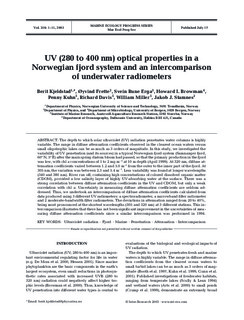| dc.description.abstract | The depth to which solar ultraviolet (UV) radiation penetrates water columns is highly
variable. The range in diffuse attenuation coefficients observed in the clearest ocean waters versus
small oligotrophic lakes can be as much as 3 orders of magnitude. In this study, we investigated the
variability of UV penetration (and its sources) in a typical Norwegian fjord system (Samnanger fjord,
60°N, 5° E) after the main spring diatom bloom had passed, so that the primary production in the fjord
was low, with chl a concentrations of 1 to 2 mg m–3 at 10 m depth (April 1999). At 320 nm, diffuse attenuation
coefficients varied between 1.2 and 5.0 m–1 from the outer to the inner part of the fjord. At
305 nm, the variation was between 2.3 and 5.4 m–1. Less variability was found at longer wavelengths
(340 and 380 nm). River run off, containing high concentrations of colored dissolved organic matter
(CDOM), provided a low salinity layer of highly UV-absorbing water at the surface. There was a
strong correlation between diffuse attenuation coefficients in the UV and CDOM, but only a weak
correlation with chl a. Uncertainty in measuring diffuse attenuation coefficients are seldom addressed.
Thus, we undertook an intercomparison of diffuse attenuation coefficients calculated from
data produced using 3 different UV radiometers: a spectroradiometer, a narrowband filter radiometer
and 2 moderate-bandwidth filter radiometers. The deviations in attenuation ranged from 20 to 40%,
being most pronounced at the shortest wavelengths (305 and 320 nm) at 3 different stations. This intercomparison
illustrates that there has not been significant improvement in the uncertainties of measuring
diffuse attenuation coefficients since a similar intercomparison was performed in 1994. | en |
